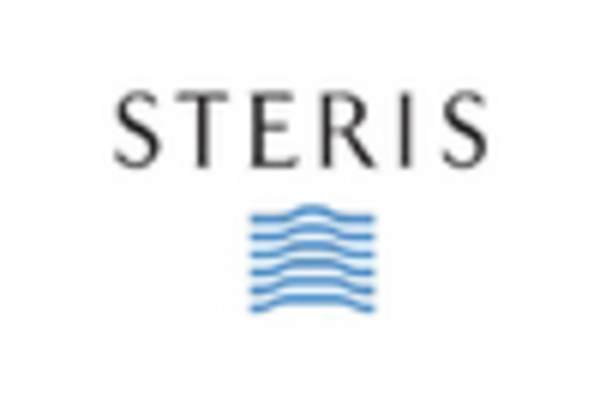Rising Healthcare Expenditure
The increasing healthcare expenditure in Japan is a pivotal driver for the medical device-cleaning market. As the government allocates more funds towards healthcare services, hospitals and clinics are likely to invest in advanced cleaning solutions to ensure patient safety and compliance with hygiene standards. In 2025, healthcare spending in Japan is projected to reach approximately $500 billion, reflecting a growth rate of around 5% annually. This surge in expenditure is expected to enhance the demand for effective cleaning solutions, thereby propelling the medical device-cleaning market. Furthermore, the emphasis on maintaining high standards of cleanliness in medical facilities is likely to drive the adoption of innovative cleaning technologies, which could further stimulate market growth.
Increased Focus on Infection Control
The heightened focus on infection control within healthcare settings is a crucial driver for the medical device-cleaning market. In Japan, healthcare facilities are increasingly prioritizing infection prevention strategies to safeguard patient health. This focus is reflected in the implementation of rigorous cleaning protocols and the adoption of specialized cleaning products designed to eliminate pathogens effectively. The market for cleaning solutions tailored for infection control is projected to grow significantly, with an expected increase of 6% annually through 2025. As hospitals and clinics strive to maintain high standards of cleanliness, the demand for effective medical device-cleaning solutions is likely to escalate, further supporting market growth.
Technological Integration in Healthcare
The integration of advanced technologies in healthcare is reshaping the medical device-cleaning market. Innovations such as automated cleaning systems and smart monitoring solutions are becoming increasingly prevalent in medical facilities across Japan. These technologies not only enhance the efficiency of cleaning processes but also ensure compliance with stringent hygiene standards. The market for automated cleaning solutions is expected to grow at a CAGR of 7% through 2025, driven by the need for consistent and reliable cleaning outcomes. As healthcare providers seek to optimize their operations and reduce the risk of hospital-acquired infections, the demand for technologically advanced cleaning solutions is likely to rise, thereby propelling the medical device-cleaning market forward.
Regulatory Framework and Compliance Requirements
The regulatory framework governing healthcare practices in Japan plays a vital role in shaping the medical device-cleaning market. Stringent regulations and compliance requirements necessitate that healthcare facilities adhere to specific cleaning standards to ensure patient safety. The Ministry of Health, Labour and Welfare has established guidelines that mandate regular cleaning and disinfection of medical devices. As a result, healthcare providers are compelled to invest in cleaning solutions that meet these regulatory standards. The ongoing evolution of these regulations is expected to drive innovation within the medical device-cleaning market, as manufacturers develop products that comply with the latest guidelines. This dynamic regulatory environment is likely to foster growth and enhance the overall quality of cleaning solutions available in the market.
Aging Population and Increased Surgical Procedures
Japan's aging population is a significant factor influencing the medical device-cleaning market. With a demographic shift towards an older population, there is a corresponding rise in surgical procedures and medical interventions. By 2025, it is estimated that over 30% of the population will be aged 65 and above, leading to an increased demand for surgical services. This trend necessitates stringent cleaning protocols for medical devices to prevent infections and ensure patient safety. Consequently, healthcare facilities are likely to invest more in cleaning solutions that meet the rigorous standards required for surgical instruments and devices. The medical device-cleaning market is thus positioned to benefit from this demographic trend, as the need for effective cleaning solutions becomes more pronounced.

















Leave a Comment